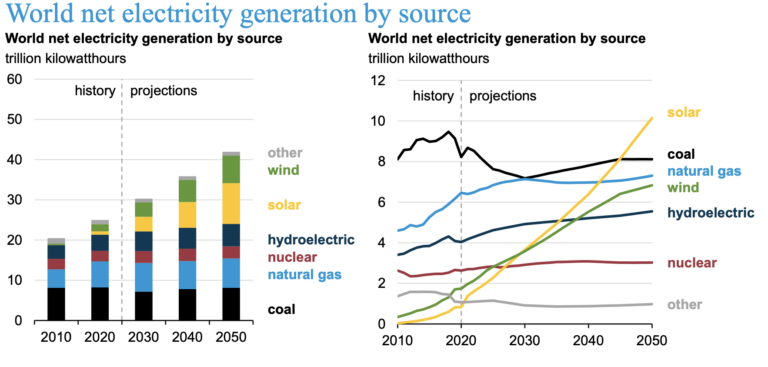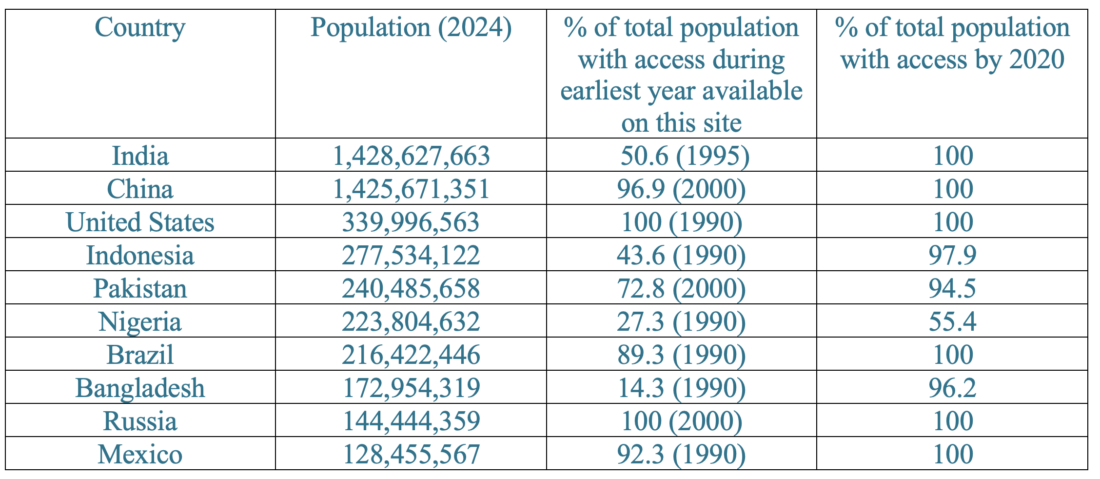Before moving on to global perspectives of electricity generation, I want to talk about a recent perspective that appeared in last week’s NYT Climate section.
The article makes the point that the recent growth in the use of electricity in the US, which I described in last week’s blog, requires a significant increase in the grid capacity in the US. It also gives an example of how to achieve this:
One of the biggest obstacles to expanding clean energy in the United States is a lack of power lines. Building new transmission lines can take a decade or more because of permitting delays and local opposition. But there may be a faster, cheaper solution, according to two reports released Tuesday.
Replacing existing power lines with cables made from state-of-the-art materials could roughly double the capacity of the electric grid in many parts of the country, making room for much more wind and solar power.
That’s an interesting idea and might be worth a try.
I will shift now to the part of the energy system that was missing from the CCNY conference described in last week’s blog: the global perspective. The anthropogenic triggering of climate change, caused by changes in the chemistry of the atmosphere, is a global phenomenon. All components of governance worldwide need to be involved in minimizing the impacts. Figure 1 shows two graphs, published by the EIA (Energy Information Administration), that summarize global electricity use.

Figure 1 – World net electricity generation (Source: Institute for Energy Research)
The changes in global electricity production in 2022 are summarized by the Enerdata yearbook:
The share of electricity in final energy consumption remained stable at 20.4% in 2022 (+3 point compared to 2010).
In 2022, the share of electricity in global final consumption remained stable at over 20%, despite a 0.3 point increase in the BRICS. It has increased by 3 pts. since 2010 (17%), as an increasing share of electricity is used in industry, residential and services sectors, and more recently, in the road transport sector with the development of the electric vehicles fleet. Since 2010, electrification has increased at a steady pace in Asia (+6.8 pts.), spurred by China (+10 pts. to over 27% in 2022), India (+3.9 pts. to 18%), and Indonesia (+5.4 pts. to 14%, despite a 2.6 pts. drop in 2022). It has also increased in the Middle East (+2.8 pts. since 2010 to nearly 17%), with significant growth in Kuwait, Saudi Arabia and the United Arab Emirates, and in Latin America (+2 pt. to over 18%, especially in Chile and Mexico, which have been promoting renewables). Electrification has remained broadly stable in North America at around 22%, in Europe (+1 pt. to over 21%, despite a 3 pts. growth in Türkiye), in Australia (24%) and in Africa (10%). In Russia, it has dipped by 1 pt. since 2010 to 13%. The share of electricity in final consumption is particularly high in Norway and Sweden, which benefit from large hydro resources (47% and 33%, respectively).
Table 1 summarizes the situation in the 10 most populous countries, which account for more than 57% of the global population. The US is the only developed country on the list. All the rest are either developing or middle-income. Over one generation or so (starting around 1990), access to electric power has almost universal, apart from some Sub-Saharan African countries, as represented in the table by Nigeria. However, even with such high numbers, 133 million citizens of these 10 countries—mainly people who live in rural areas—have yet to gain access to electrical power. The global number without access to electricity is 665 million; most of them are in equatorial Africa.
Table 1 – Changes in the share of population with access to electricity as % of total population

Reference for access to electricity: Wikipedia
Reference for Population (2024): Worldometer
I addressed some of the issues with providing electricity access in India in previous blogs, starting with a blog on April 29, 2014, that discussed microgrids. I will return to that issue in next week’s blog, which will be focused on the accessibility of electric power in both poor and rich countries.
We are approaching the end of the global transition to sustainable energy, as well as a universal transition to accessibility to electric power. As shown in Figure 1, the current available electric power is still strongly dependent on fossil fuel, which fills up the atmosphere (and the oceans) with greenhouse gases that contribute to catastrophic global climate change. We need to amplify our efforts at decarbonizing our electric power. We are in the process of learning how to proceed. In some cases, it’s not obvious.
We are starting to get examples in which the shift to sustainable primary energy sources exceeds the capacity of our grids, as mentioned in the NYT piece I referenced above. Another recent example is Poland:
Grid operator PSE is struggling to manage Poland’s growing share of PV and has ordered the third curtailment of renewable energy capacity within a month.
“Due to the oversupply of generation in the National Power System and the need to restore the regulatory capabilities of the National Power System, PSE is introducing a non-market reduction in the generation of photovoltaic sources on March 26, 2024,” PSE said in a brief statement this week.
It has announced three one-hour curtailments of 1,201 MW, 1,877 MW and 1,711 MW from 11:00 am to 2 pm.
This is the grid operator’s third renewable energy curtailment this year. All of them have taken place in March, with the latest one specifically referring to PV installations alone.
On Tuesday morning of this week, around 10 am, photovoltaics produced and fed 9.7 GWh of electricity into the grid, according to the energy.insrat.pl portal. This represented around 45% of the total electricity production in the country, making solar the nation’s biggest energy source, followed by coal at around 27%.
In other words, for the third time this year, they had so much sustainable energy that they couldn’t use it all because the system could not support the surplus. The call to expand the grid does not apply only internally in a country but, as in Poland’s case, internationally. I will return to this issue in a later blog.
